- Home
- Robert E. Howard
The Horror Stories of Robert E. Howard Page 2
The Horror Stories of Robert E. Howard Read online
Page 2
Kane enlists the aid of his blood brother, the shaman N’Longa (and what is a God-fearing Puritan doing with a shaman blood brother, anyway?), in combatting an ancient race of walking dead. Again we find Howard challenging the traditions: What are these creatures? Kane calls them vampires, but they are not the blood drinkers of Dracula and its imitators. There is a host of them swarming the hills, and Kane finds he must fight demons with demonry.
In 1930, Howard and Lovecraft at last began that correspondence that has come to be recognized as perhaps the greatest in fantasy circles. The two discussed and debated myriad topics, and inevitably the ideas found their way into each author’s work. Howard perhaps shows the influences more directly and openly, at least at first. The early stages of the epistolary friendship inspired the younger writer to experiment with stories in the Lovecraftian vein, producing “The Children of the Night,” “The Black Stone” (thought by many to be the finest Cthulhu Mythos story not written by Lovecraft), “The Thing on the Roof,” and the last of his Solomon Kane stories, “The Footsteps Within,” within a matter of months.
Because Howard was—consciously or unconsciously—emulating the Lovecraft style, and making use of terms or concepts from Lovecraft, these stories are frequently thought of as belonging to the Cthulhu Mythos. A word about this is in order.
The Cthulhu Mythos refers to a sort of pseudomythology that originated in the work of Lovecraft, many of whose stories are loosely linked by being set in a fictional New England (with the towns of Arkham, Kingsport, Dunwich, and Innsmouth, among others), and by their references to various cosmic entities that are entirely indifferent to man but nevertheless are worshipped as gods by some cultists (Cthulhu, Yog-Sothoth, Nyarlethotep, etc.). Lovecraft inserted glancing references to these entities in some of the work he revised for other authors, like Adolphe de Castro and Zelia Bishop, and a few people noticed, including Robert E. Howard. In one of his early letters to Lovecraft, Howard inquired about these entities:
“I have noted in your stories you refer to Cthulhu, Yog Sothoth, R’lyeh, Yuggoth etc. Adolph de Castro, I note, mentions these gods, places, or whatever they are, only the spelling is different, as Cthulutl, Yog Sototl. Both you and he, I believe, have used the phrase fhtaghn…. Would it be asking too-much to ask you to tell me the significance of the above mentioned names or terms? And the Arab Alhazred, and the Necronomicon. The mention of these things in your superb stories have whetted my interest immensely. I would extremely appreciate any information you would give me regarding them.”
Lovecraft was quick to disabuse Howard of the idea that there was some body of esoteric lore that his scholarship had missed:
“Regarding the solemnly cited myth-cycle of Cthulhu, Yog Sothoth, R’lyeh, Nyarlathotep, Nug, Yeb, Shub-Niggurath, etc., etc.—let me confess that this is all a synthetic concoction of my own, like the populous and varied pantheon of Lord Dunsany’s “Pagana.” The reason for its echoes in Dr. de Castro’s work is that the latter gentleman is a revision-client of mine—into whose tales I have stuck these glancing references for sheer fun. If any other clients of mine get work placed in W.T., you will perhaps find a still-wider spread of the cult of Azathoth, Cthulhu, and the Great Old Ones! The Necronomicon of the mad Arab Abdul Alhazred is likewise something which must yet be written in order to possess objective reality…. Long has alluded to the Necronomicon in some things of his—in fact, I think it is rather good fun to have this artificial mythology given an air of verisimilitude by wide citation.” Lovecraft mentioned that Clark Ashton Smith was beginning a similar pseudomythology involving “the furry toad-god Tsathoggua,” and suggested that he might incorporate Howard’s Kathulos (from “Skull-Face”) into some future tale.
Howard was not long in joining the fun. Within two months of receiving Lovecraft’s reply, he had submitted “The Children of the Night” and it had been accepted by Weird Tales. In it he had referred to Lovecraft’s “The Call of Cthulhu” as one of the three “master horror-tales” (the others being Poe’s “The Fall of the House of Usher” and Machen’s The Novel of the Black Seal) and had made his own first contribution to the Mythos, in the form of the German scholar Von Junzt and his forbidden tome, Nameless Cults. He would soon make other contributions, such as the mad poet Justin Geoffrey and the alien entity Gol-goroth. Other of his creations, such as the serpent men of Valusia (from the Kull series), Bran Mak Morn, and, indeed, Kathulos, would be adopted by Lovecraft and others in their own tales.
But we must draw an important distinction here between the use of these names or concepts as “general background-material” (in Lovecraft’s words), as opposed to their being the central conceit or plot driver of a story. As David Schultz and others have noted, neither Lovecraft nor his friends made any effort to codify any of this, seeing it more as something fun, something to give a flavor of real myth and legend to the background of their stories, than as a serious attempt to create a mythos. (Lovecraft himself used the tongue-in-cheek term “Yog-Sothothery”). Thus, Howard may occasionally refer to one of Lovecraft’s cosmic entities or allude to the Necronomicon or R’lyeh, but these mentions are usually incidental to the actual story. While it is fun to play the Mythos game, it should not lead the reader to assume that Howard (or others of Lovecraft’s peers) were consciously attempting to write Mythos stories.
One story, for example, in which glancing Mythos references are found, but which is wholly a Robert E.
Howard story, is “Worms of the Earth,” featuring another of Howard’s great heroic fantasy characters, the Pictish king Bran Mak Morn: last in a line of kings stretching back into mankind’s dawn, born to lead a savage, degenerated people in a last-ditch effort to prevent the legions of Roman Britain from overrunning their northern homeland, knowing that the fight will ultimately be lost but refusing to surrender. The “hideous and compelling power” that Lovecraft found in the story does not come from monsters or a sense of cosmic despair: it comes from watching the terrible consequences that flow from an all-too-human paroxysm of anger and desire for revenge. The story is considered by many Howard fans and scholars to be his finest tale; it works not only as an extraordinary heroic fantasy, but as a grim and atmospheric work of horror, and is perhaps his most effective use of the “little people” motif.
Howard’s letters to Lovecraft frequently included tales of the old West, or of current conditions and events in Texas, and Lovecraft, himself an ardent regionalist (most of his stories being set in a fictional New England), encouraged Howard to make greater use of his native Southwest and its traditions in his fiction. This encouragement eventually prodded him into the creation of several of his finest and most distinctive works of horror or the supernatural, with tales set in the Southwest or in the “piney woods” of the Texas-Arkansas borderlands.
The first of these “regional” works to appear in print was “The Horror from the Mound,” set in West Texas and featuring a young cowpuncher who laments his decision to give up his life as a cowboy to buy a farm. The story reflects two threads from Howard’s letters to Lovecraft: his considerable sympathy for farmers, who were struggling mightily as the Depression began to settle over the land; and his interest in the legends of lost Spanish treasures, which have been popular in Texas since before the Spanish left.
Most important, of course, Howard shows he is still interested in taking on tropes of the horror genre—here, the vampire again—and giving them an unusual treatment. Too unusual for one poor Weird Tales reader, who complained that “The Horror from the Mound” [contained] no less than four flagrant breaches of accepted vampire tradition.” As we have seen, Howard was no respecter of literary traditions. In fact, it might be said that, with this story, Howard had finally succeeded in bringing together all three of his favorite genres—western, adventure, and the weird—to create the first “weird western.”
Following “The Horror from the Mound,” Howard turned increasingly to his native environs for other tales of horror and the supernatural. “
The Valley of the Lost” makes use of the theme of little people, essentially transferring elements of “The Children of the Night” and “Worms of the Earth” to the Southwest and giving the story an ending we might more expect of Lovecraft than of Howard. “The Man on the Ground” is a very short tale but a gripping meditation on the power of hate, a crystallization of all Howard had learned in his study of Texas feuds. It is a fine example of that ability we noted earlier to lend almost tangible form to an abstract emotion. “Old Garfield’s Heart,” in which early Texas Indian fights and legends play a prominent part, is about as close to home as Howard gets in a story: Lost Knob is his fictional counterpart to his hometown of Cross Plains. The dark magic of “The Dead Remember” is all the darker when set against the authentic backdrop of a cattle drive. These stories, along with his increasingly confident handling of westerns, convinced Lovecraft that “in time he would have made his mark…with some folk-epic of his beloved southwest.”
The story generally considered Howard’s finest horror tale, though, was not set in the Southwest, but in the South. Texas straddles both geographic regions, and Howard explained to Lovecraft that a dividing line ran between Dallas, which was in East Texas and looked to the south, and Fort Worth, which was, as its slogan goes, “Where the West Begins.” Bagwell, where the Howards lived when Robert was about eight years old, is east of Dallas, on the fringes of the Piney Woods area that takes in parts of southwestern Arkansas, northwestern Louisiana, and East Texas. And it is in Bagwell that we find the genesis of “Pigeons from Hell.”
“I well remember the tales I listened to and shivered at, when a child in the ‘piney woods’ of East Texas, where Red River marks the Arkansaw and Texas boundaries,” Howard wrote to Lovecraft (using the phonetic spelling for his father’s native state). “There were quite a number of old slave darkies still living then. The one to whom I listened most was the cook, old Aunt Mary Bohannon…. Another tale she told that I have often met with in negro-lore. The setting, time and circumstances are changed by telling, but the tale remains basically the same. Two or three men—usually negroes—are travelling in a wagon through some isolated district—usually a broad, deserted river-bottom. They come on to the ruins of a once thriving plantation at dusk, and decide to spend the night in the deserted plantation house. This house is always huge, brooding and forbidding, and always, as the men approach the high columned verandah, through the high weeds that surround the house, great numbers of pigeons rise from their roosting places on the railing and fly away. The men sleep in the big front-room with its crumbling fire-place, and in the night they are awakened by a jangling of chains, weird noises and groans from upstairs. Sometimes footsteps descend the stairs with no visible cause. Then a terrible apparition appears to the men who flee in terror. This monster, in all the tales I have heard, is invariably a headless giant, naked or clad in shapeless sort of garment, and is sometimes armed with a broad-axe. This motif appears over and over in negro-lore.”
Just how familiar Howard might have been with “negro-lore” must remain a matter of some conjecture (he lived most of his life, other than that short period in Bagwell and a few weeks in New Orleans, in communities in which there were few, if any, African Americans), but certainly he used what he did know to good effect. Critical consensus seems to concur with Stephen King’s remark that “Pigeons from Hell”
is “one of the finest horror stories of [the twentieth] century.” It was later adapted for television’s Thriller! , an anthology series hosted by Boris Karloff, and is widely regarded as the best episode of that series, “one of the most truly frightening journeys into small-screen fantasy.”
“Pigeons from Hell” and other of the piney woods stories (such as “The Shadow of the Beast” and
“Black Canaan”) contain some language and attitudes that many readers will find uncomfortable or offensive. Not to put too fine a point on it, Howard was a product of his time and place, the early-twentieth-century South and Southwest, and casually racist attitudes went along with it. In addition, he was writing for the pulp magazines, and stereotyping of ethnic groups served as a kind of shorthand for the writers and readers of this form of popular fiction: Asians, Native Americans, Latins, Irish, Swedes, Eastern Europeans, and others are frequently not treated any better in pulp stories than blacks, whether African or African American, are. But in “Pigeons from Hell,” “Black Canaan,” “The Dead Remember,” and other tales, Howard also displays his considerable gifts for narrative and invention, and his extraordinary talent for creating that atmosphere of “fear and dread suspense” that Lovecraft noted; and I believe that a closer look at the stories reveals considerable sympathy with the downtrodden.
In “The Dead Remember,” for instance, it is clear that Howard’s sympathies lie with Joel and Jezebel, rather than with the cowboy who murders them in a drunken rage, and in “Pigeons from Hell,” it seems equally clear that his sympathies lie with the “mulatto” maid Joan and not with her white tormentor, Celia Blassenville. Howard’s own extreme sensitivity to authority (“Life’s not worth living if somebody thinks he’s in authority over you,” he told one correspondent) may have been at the root of his discomfort with mistreatment of slaves (“Thank God the slaves on my ancestors’ plantations were never so misused”), and this, along with pride in his Southern heritage, may be why he chose to make the Blassenvilles Creoles from the West Indies rather than Southerners. In “Black Canaan,” it is true that the villains are Saul Stark, the conjure man, and his “quadroon” accomplice, the Bride of Damballah, but here I believe Howard’s sympathies lie as much with the swamp blacks, over whom Stark holds sway not so much by holding out the promise of liberation as through fear of being “put in the swamp,” as with the white inhabitants of the town. In fact, when he names the white town Grimesville, the black settlement Goshen, and the region in which both are found Canaan, I think he may be subtly—perhaps unconsciously—displaying his sympathies with the oppressed.
We have appended to this volume four fragmentary tales that, so far as can be learned, Howard never completed. Two of these will fall into the Cthulhu Mythos: “The House” concerns Justin Geoffrey, and provides a tantalizing hint of where his madness began; the “Untitled Fragment” that begins “Beneath the glare of the sun…” explicitly links the Conan series to the Mythos, through discussion of Conan’s Hyborian Age in Nameless Cults. (The title Unaussprechlichen Kulten, used here by Howard for the only time, was actually coined by August Derleth, at the request of Lovecraft, who had wanted a title that would serve as the original German. Lovecraft ardently promoted the use of Derleth’s version because of its “sinister, mouth-filling rhythm.”) The other two fragments employ, in my view, some very interesting concepts. “Golnor the Ape,” with its protagonist who had “lived in two worlds” and who is yet able to see and converse with beings of that mysterious “other” world, and “Spectres in the Dark,” in which men seem to be driven mad by things that move in the shadows but cannot be seen, offer intriguing glimpses into the fertile imagination of Robert E. Howard.
Settle back in your chair and let that imagination sweep you into worlds of mystery, adventure, and terror. You might first want to be sure there are no deep shadows in the room.
Rusty Burke
February 2008
In the Forest of Villefère
The sun had set. The great shadows came striding over the forest. In the weird twilight of a late summer day, I saw the path ahead glide on among the mighty trees and disappear. And I shuddered and glanced fearfully over my shoulder. Miles behind lay the nearest village–miles ahead the next.
I looked to left and to right as I strode on, and anon I looked behind me. And anon I stopped short, grasping my rapier, as a breaking twig betokened the going of some small beast. Or was it a beast?
But the path led on and I followed, because, forsooth, I had naught else to do.
As I went I bethought me, “My own thoughts will rout me, if I be not aware. What is
there in this forest, except perhaps the creatures that roam it, deer and the like? Tush, the foolish legends of those villagers!”
And so I went and the twilight faded into dusk. Stars began to blink and the leaves of the trees murmured in the faint breeze. And then I stopped short, my sword leaping to my hand, for just ahead, around a curve of the path, someone was singing. The words I could not distinguish, but the accent was strange, almost barbaric.
I stepped behind a great tree, and the cold sweat beaded my forehead. Then the singer came in sight, a tall, thin man, vague in the twilight. I shrugged my shoulders. A man I did not fear. I sprang out, my point raised.
“Stand!”
He showed no surprize. “I prithee, handle thy blade with care, friend,” he said.
Somewhat ashamed, I lowered my sword.
“I am new to this forest,” I quoth, apologetically. “I heard talk of bandits. I crave pardon. Where lies the road to Villefère?”
“Corbleu, you’ve missed it,” he answered. “You should have branched off to the right some distance back. I am going there myself. If you may abide my company, I will direct you.”
I hesitated. Yet why should I hesitate?
“Why, certainly. My name is de Montour, of Normandy.”
“And I am Carolus le Loup.”

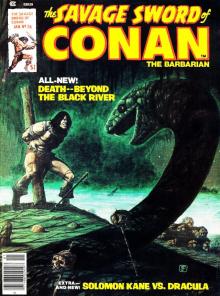 Beyond the Black River
Beyond the Black River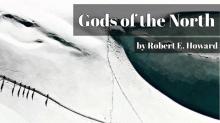 Gods of the North
Gods of the North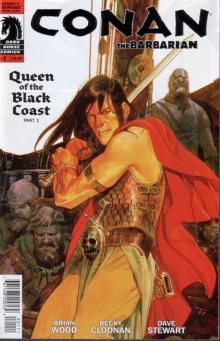 Queen of the Black Coast
Queen of the Black Coast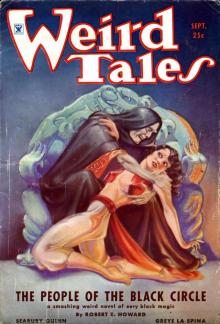 The People of the Black Circle
The People of the Black Circle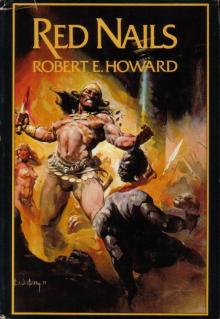 Red Nails
Red Nails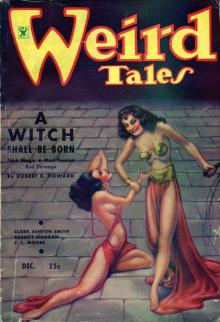 A Witch Shall Be Born
A Witch Shall Be Born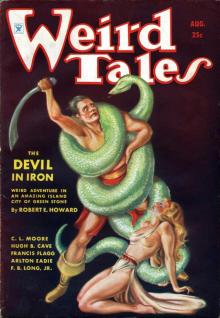 The Devil in Iron
The Devil in Iron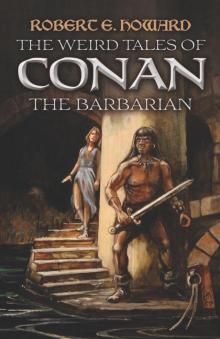 The Weird Tales of Conan the Barbarian
The Weird Tales of Conan the Barbarian The Bloody Crown of Conan
The Bloody Crown of Conan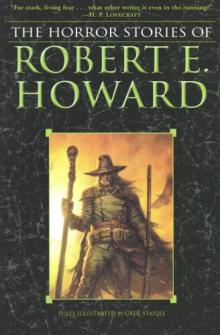 The Horror Stories of Robert E. Howard
The Horror Stories of Robert E. Howard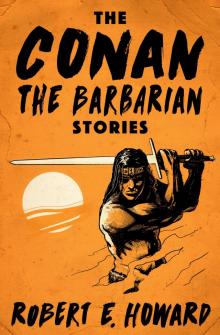 Conan the Conqueror
Conan the Conqueror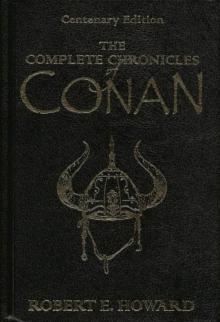 Conan the Barbarian
Conan the Barbarian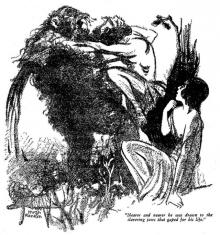 Shadows in the Moonlight
Shadows in the Moonlight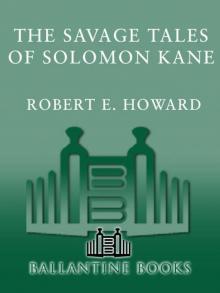 The Savage Tales of Solomon Kane
The Savage Tales of Solomon Kane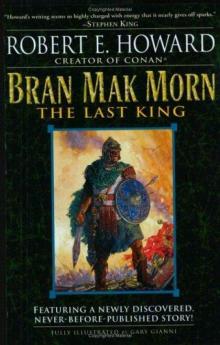 Bran Mak Morn: The Last King
Bran Mak Morn: The Last King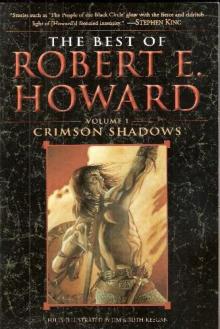 The Best of Robert E. Howard Volume One: Crimson Shadows
The Best of Robert E. Howard Volume One: Crimson Shadows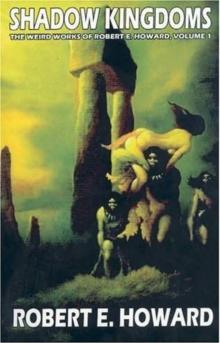 The Best of Robert E. Howard: Crimson Shadows (Volume 1)
The Best of Robert E. Howard: Crimson Shadows (Volume 1) Black Hounds of Death
Black Hounds of Death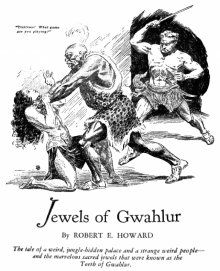 Jewels of Gwahlur
Jewels of Gwahlur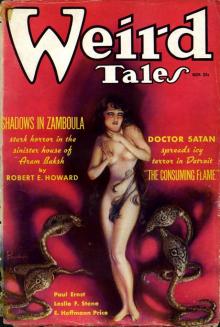 Shadows in Zamboula
Shadows in Zamboula The Coming of Conan the Cimmerian
The Coming of Conan the Cimmerian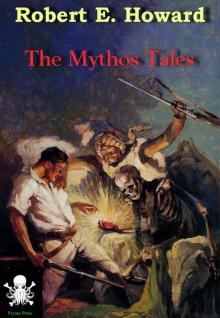 The Mythos Tales
The Mythos Tales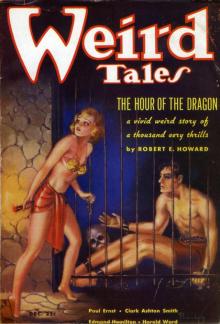 The Hour of the Dragon
The Hour of the Dragon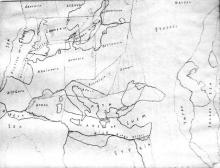 The Hyborian Age
The Hyborian Age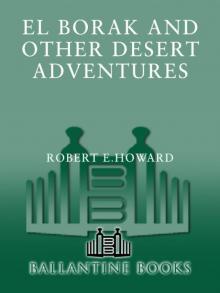 El Borak and Other Desert Adventures
El Borak and Other Desert Adventures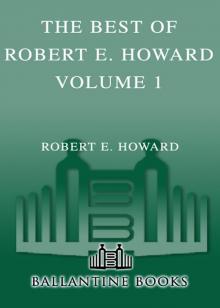 The Best of Robert E. Howard Volume 1 The Best of Robert E. Howard Volume 1
The Best of Robert E. Howard Volume 1 The Best of Robert E. Howard Volume 1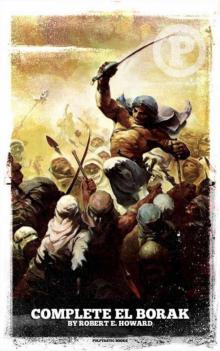 El Borak: The Complete Tales
El Borak: The Complete Tales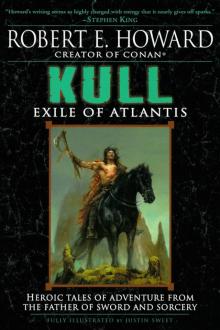 Kull: Exile of Atlantis
Kull: Exile of Atlantis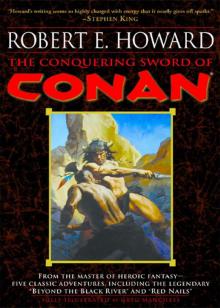 The Conquering Sword of Conan
The Conquering Sword of Conan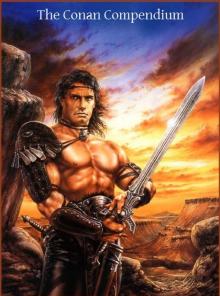 The Conan Compendium
The Conan Compendium The Conan Chronicles: Volume 1: The People of the Black Circle
The Conan Chronicles: Volume 1: The People of the Black Circle The Complete Chronicles of Conan: Centenary Edition
The Complete Chronicles of Conan: Centenary Edition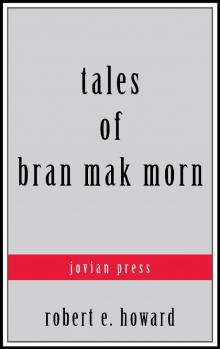 Tales of Bran Mak Morn (Serapis Classics)
Tales of Bran Mak Morn (Serapis Classics)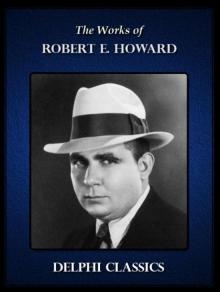 Delphi Works of Robert E. Howard (Illustrated) (Series Four)
Delphi Works of Robert E. Howard (Illustrated) (Series Four)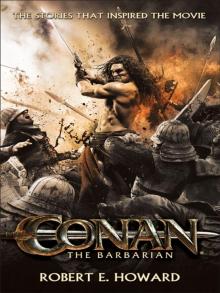 Conan the Barbarian: The Stories That Inspired the Movie
Conan the Barbarian: The Stories That Inspired the Movie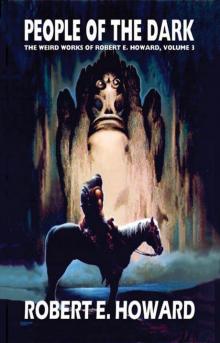 People of the Dark Robert Ervin Howard
People of the Dark Robert Ervin Howard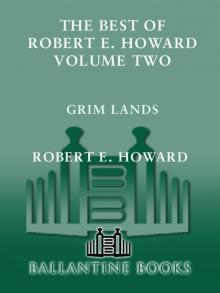 Grim Lands
Grim Lands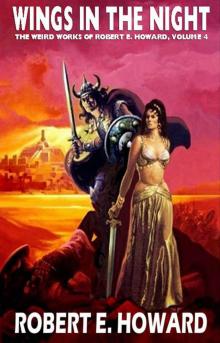 Wings in the Night
Wings in the Night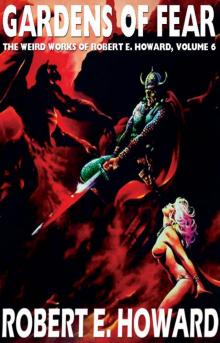 Gardens of Fear
Gardens of Fear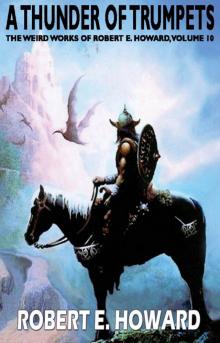 A Thunder of Trumpets
A Thunder of Trumpets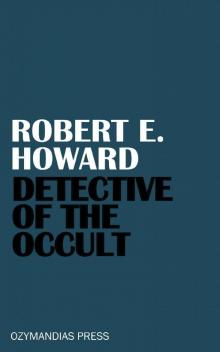 Detective of the Occult
Detective of the Occult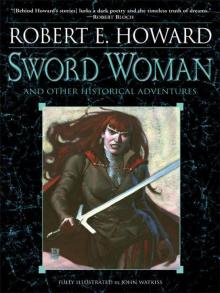 Sword Woman and Other Historical Adventures
Sword Woman and Other Historical Adventures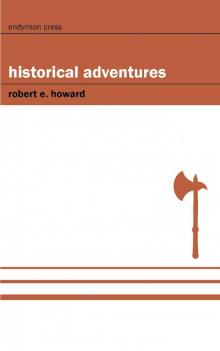 Historical Adventures
Historical Adventures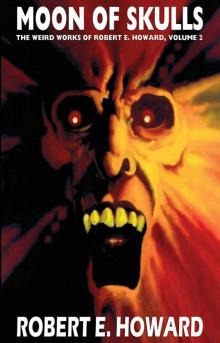 Moon of Skulls
Moon of Skulls The Robert E. Howard Omnibus: 97 Collected Stories
The Robert E. Howard Omnibus: 97 Collected Stories The Pirate Story Megapack: 25 Classic and Modern Tales
The Pirate Story Megapack: 25 Classic and Modern Tales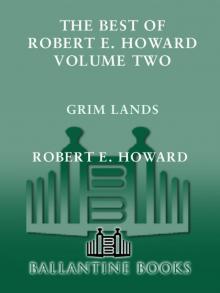 The Best of Robert E. Howard, Volume 2
The Best of Robert E. Howard, Volume 2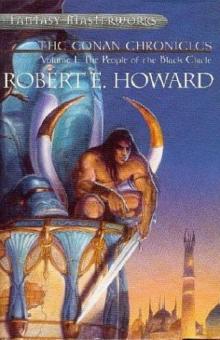 The Conan Chronicles, Vol. 1: The People of the Black Circle
The Conan Chronicles, Vol. 1: The People of the Black Circle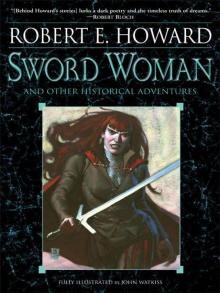 Sword Woman and Other Historical Adventures M
Sword Woman and Other Historical Adventures M The Complete Chronicles of Conan
The Complete Chronicles of Conan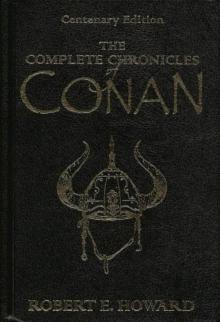 Conan the Barbarian: The Chronicles of Conan (collected short stories)
Conan the Barbarian: The Chronicles of Conan (collected short stories) The Conan the Barbarian Stories
The Conan the Barbarian Stories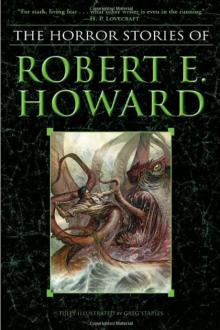 The Best Horror Stories of
The Best Horror Stories of Tigers Of The Sea cma-4
Tigers Of The Sea cma-4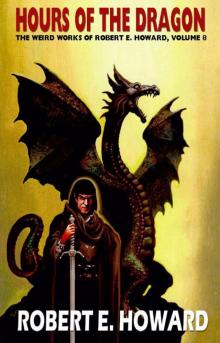 The Hours of the Dragon
The Hours of the Dragon Conan the Cimmerian: The Complete Tales (Trilogus Classics)
Conan the Cimmerian: The Complete Tales (Trilogus Classics)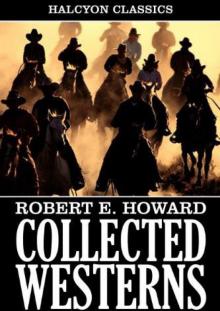 Collected Western Stories of Robert E. Howard (Unexpurgated Edition) (Halcyon Classics)
Collected Western Stories of Robert E. Howard (Unexpurgated Edition) (Halcyon Classics)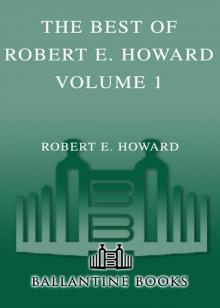 The Best of Robert E. Howard, Volume 1
The Best of Robert E. Howard, Volume 1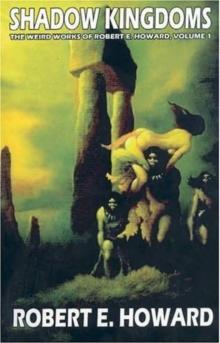 Shadow Kingdoms
Shadow Kingdoms